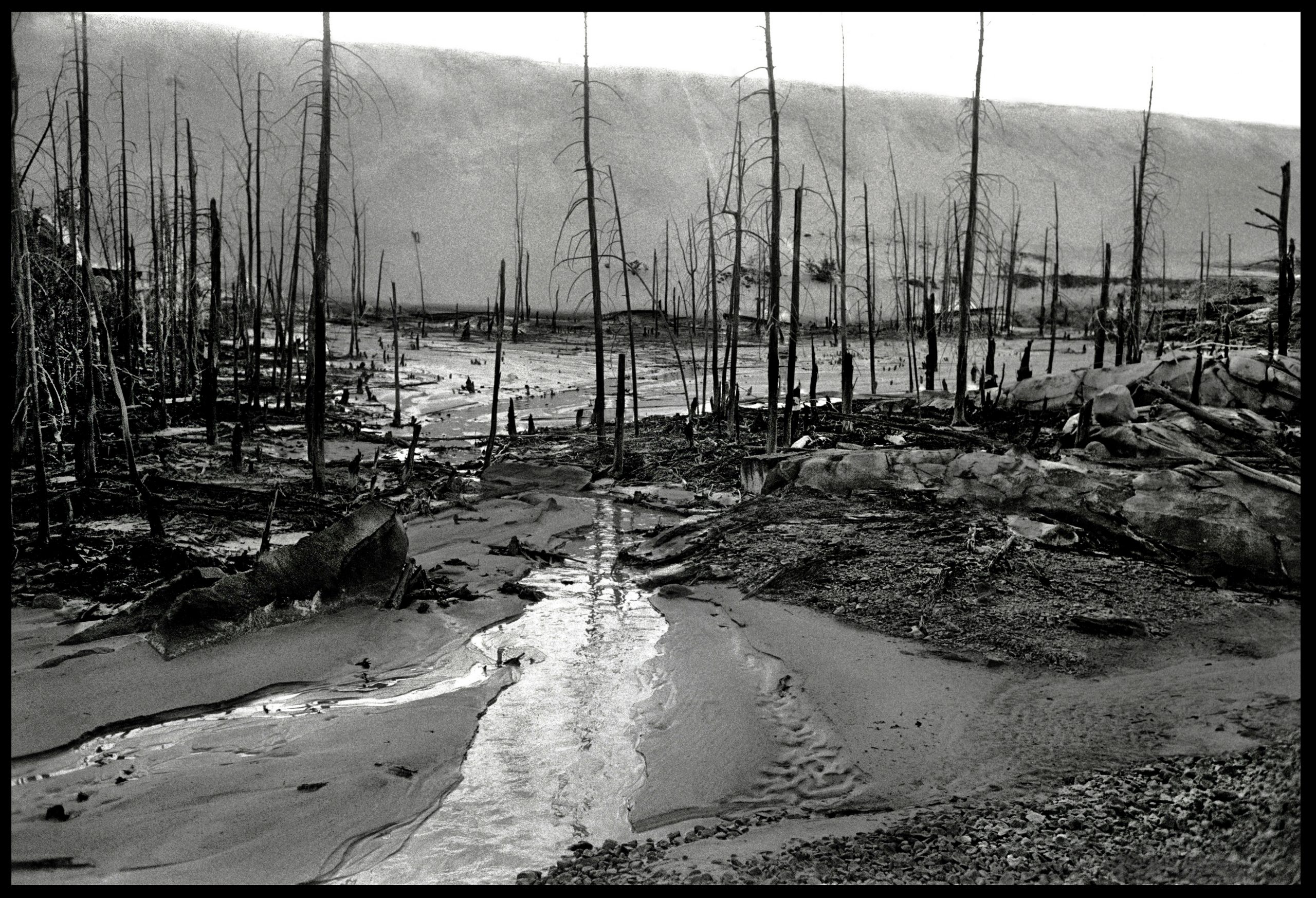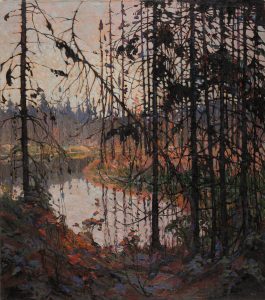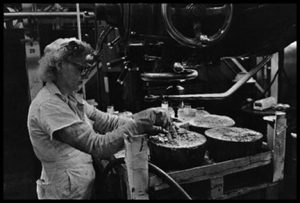Stanrock Tailings Wall, Elliot Lake, Ontario (1985)
by John O’Brian

Canada has been a major producer of uranium ore since the Second World War. Uranium mined in Canada was used to make the atomic bombs dropped on Hiroshima and Nagasaki and to produce weapons for the nuclear arsenal of the United States and Britain during the Cold War. It was also used to operate the CANDU reactor, an atomic furnace designed by Canada to produce electric power. The CANDU was sold abroad for civilian purposes, but India used it to manufacture plutonium for its atomic bomb. Canada’s nuclear footprint has had a global impact since the beginning of the atomic era. This footprint is strikingly represented in photographs, which play a pivotal role in shaping our understanding of nuclear events. I have argued that the catastrophes of Hiroshima, Nagasaki, Chernobyl, and Fukushima are part of collective memory mostly because of the existence of photographs.[1] Emblematic photographs. Few aspects of the nuclear environment have escaped the camera’s gaze. Uranium mining is no exception.
Toxic landscapes
Stanrock Tailings Wall, Elliot Lake, Ontario is a black-and-white horizontal photograph taken by the Montreal artist Robert Del Tredici. At first glance, it looks like an homage to paintings of flooded landscapes by Tom Thomson and the Group of Seven, such as Thomson’s Northern River, which the artist referred to as his “swamp painting.”

The dead trees and the mud in the foreground and middle ground of the photograph appear to have occurred naturally. But on closer inspection, the lifeless trees and the ooze surrounding them are revealed to be artificial. Visible at the top of the image is a ten-metre high wall of waste tailings from uranium mining in the Elliot Lake region of Ontario, once called “the uranium capital of the world.” Waste tailings can be up to six times more radioactive than uranium itself. The tailings have been dumped into the natural environment by the Stanrock mine, which operated from 1958-1970, and the photograph depicts a wasteland of toxic sludge that has killed the vegetation around it. In Stanrock Tailings Wall we are looking at a landscape defeated by human actions.
The Stanrock uranium tailings pond and others like it contaminated the Serpent River system that flows south from Elliot Lake into Georgian Bay on Lake Huron. In This Is My Homeland, Lorraine Rekmans remarks that the lakes in the region “were used as a dumping ground for radioactive waste . . . The ground-waters under the tailings basins are virtual rivers of poison.”[2] The poisoned rivers to which she refers flow onto the lands of the Serpent River First Nation and have adversely affected the health of its inhabitants. The lands were also used to build a manufacturing plant that supplied the mines with sulphuric acid, a leaching agent used to extract uranium from the ground. The artist Bonnie Devine, a member of the Serpent River First Nation, has produced a large mixed media drawing of the sulphur pile used to produce the acid. The dazzling yellow of the sulphur contrasts with the deadening greys and blacks of the polluted land surrounding it. Her drawing functions as a companion piece to Del Tredici’s photograph. It represents another defeated landscape.
In the fields of the bomb
Stanrock Tailings Wall is published in At Work in the Fields of the Bomb, a ground-breaking book by Del Tredici that aims to reveal what nuclear authorities have tried to keep hidden since the invention of nuclear weapons. The book sets the standard for publications on nuclear activities that combine photographs with text. Del Tredici writes in the introduction that he wants to show “the nuclear arsenal at its source” and to use photographs such as Stanrock Tailings Wall to represent the activities of the nuclear industry.[3] These activities include uranium mining and refining; scientific research and development; reactor design and construction; weapons assembly and testing; and toxic waste disposal. At the centre of the industry is uranium, the mother element that generates nuclear energy. It is the foundational ingredient in nuclear weapons.

At Work in the Fields of the Bomb counters the forces of secrecy and abstraction by putting the human body in the nuclear machine. One photograph shows an employee, who works with the dangerous material eight hours a day, collecting shavings from a block of refined uranium called a “derby” for testing in a lab. She is touching the block, which emits alpha, beta, and gamma radiation. She wears overalls, rubber gloves, safety glasses and earrings, and has a flower in her hair because it is the week before Christmas. Like Stanrock Tailings Wall, this photograph is a “counterimage.”[4] It provides a critical alternative to the mushroom cloud imagery that dominates nuclear photography. A mushroom cloud tells us that an atomic bomb has exploded, but shares little about the mass destruction occurring beneath it.
Radioactive gravesites
The photographs in At Work in the Fields of the Bomb are carefully organized by Del Tredici to tell a story. Stanrock Tailings Wall represents a radioactive site in Ontario that will remain hazardous for thousands of years. The image preceding it in the book is of a train, shunted into a siding near Munich, that is loaded with milk powder contaminated by the fallout from Chernobyl. In an effort to get rid of the radioactive product, the local government tried to sell the milk powder to Egypt. The photograph immediately following Stanrock Tailings Wall is of granite markers designating buried radioactive material at a waste disposal site in South Carolina. The markers look like gravestones.
The sequence of photographs contributes to a narrative about radioactive contamination, alerting us to threats that we would not otherwise know about. It also contributes to a narrative about Canada’s participation in a global network of nuclear industry. The participation is not always benign, as Stanrock Tailings Wall vividly demonstrates. Del Tredici’s photograph of a poisoned landscape deserves to be as widely known as Thomson’s Northern River.
About the author
John O’Brian is an art historian, writer, and curator. He is best known for his books on modern art, including Clement Greenberg: The Collected Essays and Criticism (1986), and for his exhibitions on nuclear photography such as Camera Atomica, organized for the Art Gallery of Ontario in 2015. From 1987-2017 he taught art history at the University of British Columbia, Vancouver, where he held the Brenda & David McLean Chair in Canadian Studies (2008-11) and was an Associate of the Peter Wall Institute for Advanced Studies. He has been a critic of neoconservative policies since the start of the Culture Wars in the 1980s. He is a recipient of the Thakore Award in Human Rights and Peace Studies from Simon Fraser University.
Further reading
Carpenter, Ele. The Nuclear Culture Source Book. London: Black Dog, 2016.
Del Tredici, Robert. At Work in the Fields of the Bomb. Vancouver: Douglas and McIntyre, 1987.
Donev, Jason, et al. “CANDU Reactor.” Energy Education. University of Calgary, October 18, 2021. https://energyeducation.ca/encyclopedia/CANDU_reactor.
Fitzpatrick, Blake, and Robert Del Tredici. The Atomic Photographers Guild: Visibility and Invisibility in the Nuclear Era. Toronto: Gallery TPW, 2001.
Mellor, Robynne. “Wildly Nuclear: Elliot Lake and Canada’s Nuclear Legacy.” NiCHE, June 15, 2016. https://niche-canada.org/2016/06/15/wildly-nuclear-elliot-lake-and-canadas-nuclear-legacy/.
O’Brian, John. The Bomb in the Wilderness: Photography and the Nuclear Era in Canada. Vancouver: UBC Press, 2020.
O’Brian, John, ed. Camera Atomica. London: Black Dog; Toronto: Art Gallery of Ontario, 2015.
Rekmans, Lorraine, ed. This Is My Homeland. Cutler, ON: Serpent River First Nation, 2003.
- John O’Brian, The Bomb in the Wilderness: Photography and the Nuclear Era in Canada (Vancouver: UBC Press, 2020), and John O’Brian, ed., Camera Atomica (London: Black Dog; Toronto: Art Gallery of Ontario, 2015). ↵
- Lorraine Rekmans, ed., This Is My Homeland (Cutler, ON: Serpent River First Nation, 2003), 5. ↵
- Robert Del Tredici, At Work in the Fields of the Bomb (Vancouver: Douglas and McIntyre, 1987), ix. ↵
- Blake Fitzpatrick and Robert Del Tredici, The Atomic Photographers Guild: Visibility and Invisibility in the Nuclear Era (Toronto: Gallery TPW, 2001). ↵
A sandy, hazardous waste byproduct of uranium mining.
The name of a town and region that produced large amounts of uranium during the 1950s and 1960s. It was once called the “uranium capital of the world.”

